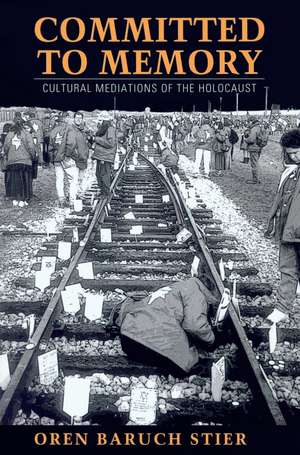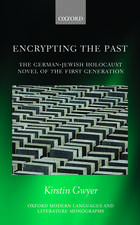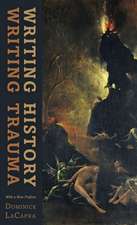Committed to Memory: Cultural Mediations of the Holocaust
Autor Oren Baruch Stieren Limba Engleză Paperback – 7 oct 2009
How is contemporary public consciousness of the Holocaust shaped and communicated? How is commitment to its memory expressed and engendered? This book offers a close and critical analysis of a range of cultural activities that mediate the Holocaust for a public increasingly distant from the events of World War II. Oren Baruch Stier argues that the manner in which those events are committed to memory, coupled with the fervent dedication to memory exhibited by many people and institutions, produces distinct memorial mediations of the Shoah.
Stier discusses how these memorializations emerge, paying attention to the ways cultural memory is embodied individually, institutionally, and technologically. He defines and examines four modes of mediation: iconic, videotestimonial, museological, and ritual-ceremonial. In each context, he analyzes how Holocaust memory is inscribed, framed, displayed, and performed through a variety of media in a range of settings. Topics include the use of Holocaust-era railway cars, Art Spiegelman's Maus volumes, novels by Emily Prager, Martin Amis, and Elie Wiesel, and a CD-ROM that incorporates excerpts from Holocaust survivor testimonies. Institutions examined range from Washington's U.S. Holocaust Memorial Museum to Los Angeles's Museum of Tolerance, from Yale's Fortunoff Video Archive for Holocaust Testimonies to the Visual History Foundation created by Steven Spielberg, to the international teen pilgrimage that is the March of the Living.
In the end, Committed to Memory asks what role forgetting can and does play in the memorial landscape, demonstrating how critical attention to our memorial investments, and to the mechanics and media of memory's construction and transmission, can uncover what is both gained and lost in these commitments.
Stier discusses how these memorializations emerge, paying attention to the ways cultural memory is embodied individually, institutionally, and technologically. He defines and examines four modes of mediation: iconic, videotestimonial, museological, and ritual-ceremonial. In each context, he analyzes how Holocaust memory is inscribed, framed, displayed, and performed through a variety of media in a range of settings. Topics include the use of Holocaust-era railway cars, Art Spiegelman's Maus volumes, novels by Emily Prager, Martin Amis, and Elie Wiesel, and a CD-ROM that incorporates excerpts from Holocaust survivor testimonies. Institutions examined range from Washington's U.S. Holocaust Memorial Museum to Los Angeles's Museum of Tolerance, from Yale's Fortunoff Video Archive for Holocaust Testimonies to the Visual History Foundation created by Steven Spielberg, to the international teen pilgrimage that is the March of the Living.
In the end, Committed to Memory asks what role forgetting can and does play in the memorial landscape, demonstrating how critical attention to our memorial investments, and to the mechanics and media of memory's construction and transmission, can uncover what is both gained and lost in these commitments.
Preț: 255.01 lei
Nou
Puncte Express: 383
Preț estimativ în valută:
48.82€ • 50.94$ • 40.92£
48.82€ • 50.94$ • 40.92£
Carte tipărită la comandă
Livrare economică 12-26 martie
Preluare comenzi: 021 569.72.76
Specificații
ISBN-13: 9781558497955
ISBN-10: 1558497951
Pagini: 296
Ilustrații: 16
Dimensiuni: 152 x 229 x 17 mm
Greutate: 0.45 kg
Ediția:First Edition
Editura: University of Massachusetts Press
Colecția University of Massachusetts Press
ISBN-10: 1558497951
Pagini: 296
Ilustrații: 16
Dimensiuni: 152 x 229 x 17 mm
Greutate: 0.45 kg
Ediția:First Edition
Editura: University of Massachusetts Press
Colecția University of Massachusetts Press
Notă biografică
Oren Baruch Stier is assistant professor of religious studies and associate director of the Judaic Studies Program at Florida International University.
Recenzii
"Many contemporary scholars—whether in Holocaust studies or other areas—plunge into a discussion of memory, as though the term and its dynamic were universally understood. Stier probes the assumptions and hypotheses that underlie much discussion of memory in an intelligent and critical way, drawing important distinctions and giving depth to the ongoing conversation."—Sara R. Horowitz, author of Voicing the Void: Muteness and Memory in Holocaust Fiction
"A rich and provocative work. . . . I recommend it with enthusiasm."—Edward T. Linenthal, author of Preserving Memory: The Struggle to Create America's Holocaust Museum
"A rich and provocative work. . . . I recommend it with enthusiasm."—Edward T. Linenthal, author of Preserving Memory: The Struggle to Create America's Holocaust Museum









